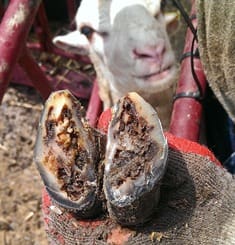 FOOTROT has been confirmed in several sheep flocks in South Australia’s mid-north around Clare after increased spring and summer rainfall.
FOOTROT has been confirmed in several sheep flocks in South Australia’s mid-north around Clare after increased spring and summer rainfall.
PIRSA senior animal health adviser Chris Van Dissel said about seven flocks have been confirmed with virulent footrot, with a similar number where the disease is not yet full expressed.
PIRSA officers are still tracing and inspecting neighbouring flocks and today hosted an information for the region’s sheep producers to describe the disease and treatment options.
Mr Van Dissel gave credit to producers who have reported the hoof disease in their flocks to PIRSA.
“Hats off to them this year because they have noticed it and they have reported it.”
Footrot is a notifiable disease in South Australia and other states.
“Farmers in the mid-north are up against it, because unlike in the south-east or the Adelaide Hills, it just doesn’t become apparent to them that it is an issue; the percentage of lame sheep is very low and it goes unnoticed in most years.”
Click here to get the latest Sheep Central story links sent to your email inbox.
Mr Van Dissel said the appearance of the condition in Clare district flocks does not represent an outbreak.
“I would just say it is a manifestation of a disease that is always present.”
“This isn’t something that has just come into the area, the infection is always there.
“It just doesn’t always get the opportunity to get as bad as what it is this year.”
Other states have also had problems with footrot in flocks with increased spring and summer rainfall, including western New South Wales.
“And it is nothing new to our wetter areas, it is just that the mid-north sits on that rainfall of 400-500mm, you get a dry spring you don’t see any, you get a wet spring, you see more.
“Up there, probably one out of 10 years you see it, the other nine years it is a bit more covert,” Mr Van Dissel said.
He said spring and summer rainfall has made underlying footrot infection on a few properties more visible to farmers. Most affected flocks are Merinos, with some crossbreds. The disease has not yet been traced to introduced sheep.
Flocks with confirmed virulent are subject to movement restriction orders restricting sheep movement to sale for slaughter only and not to other farmers.
“Most of those (affected) properties have already entered their eradication program, which involves three full inspections of all the sheep in the flock, then footbathing and repeat inspections to identify animal that still have lesions and ultimately culling them,” Mr Van Dissel said.
Affected flocks will be inspected in spring this year and if clear of lesions, the movement restriction orders can be lifted.
“It’s not a death sentence, it’s another thing that farmers have to manage and if they’ve got the right tools and the right information they should be able to do that.”
The first footrot detection in mid-north flocks was made in a saleyard in March last year and most affected flocks were identified in the recent spring and during summer.
For more information contact the PIRSA Clare office on 08 8842 6222.



HAVE YOUR SAY